Look for the pests below. Monitor aphids if a treatment was not applied
in November. Eggs found in treated orchards are likely to be dead. Names
link to more information on identification and management.
Click on photos to enlarge

Mealy plum aphid egg
Identification tip: Eggs are black, oval, and laid on
or adjacent to buds. Waxy filaments (not visible here) may be
seen with a hand lens. |
No photo available
Leaf curl plum aphid egg
Identification tip: Closely resembles the mealy plum aphid egg but is smoother and has no waxy
filaments. |
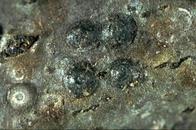
San Jose scale nymphs (healthy)
Identification tip: The four round, dark scales in the
center are the black cap stage, the most common overwintering
form. The earlier white cap stage is to left. |
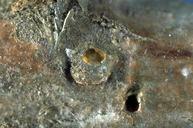
San Jose scale (parasitized)
Identification tip: Scales parasitized the previous season
will have a round hole in them where the adult parasite emerged. |

European fruit lecanium nymphs
Identification tip: Look for legless, immobile yellow
insects on twigs. Older nymphs may have brown markings and a
distinct center ridge. |
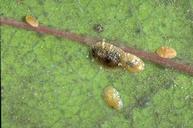
European fruit lecanium scale (parasitized)
Identification tip: Parasitized lecanium scales, such
as the one in the center here, turn black. |
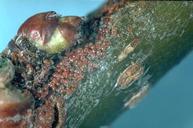
European red mite eggs
Identification tip: Masses of eggs may be laid together.
Each slightly flattened red egg has a long, spinelike projection,
called a stipe, at the top that can be seen with a hand lens. |
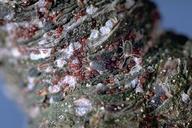
Brown mite eggs
Identification tip: Brown mite eggs (shown here with adults)
look like those of European red mite, but lack the stipe. |


